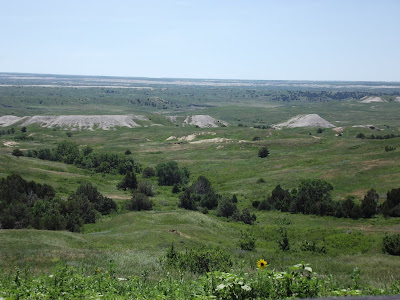Our first
stop today was the South Dakota Air & Space Museum at Ellsworth Air Force
Base. I always enjoy our Air Force
Museum tours, since Greg was in the Air Force Reserves I have a personal tour
guide who can explain to me what I’m looking at.
This is a
B-1B Lancer. On March 2011, under
blizzard conditions the call came: could the 28th Bomb Wing be ready
for action in Libya in less than two days?
Experts in all systems applied their skills. Munitions teams built 145 weapons in 20
hours. Logistics specialists delivered
parts from the warehouse to the flight line.
From this enormous effort aircrews launched the first B-1 combat mission
ever flown from the continental U.S.
They returned 72 hours and 2 bombing missions later, exhausted, having
hit nearly 100 targets with 98% accuracy.
This B-1B Engineering
Research Simulator was just beyond my comprehension. Look at all those buttons! And, there were more on the ceiling I couldn’t
get in the picture.
One of the
displays inside the museum told about the “Berlin Candy Bombers”, I had never
heard this story. It appears candy
became a significant morale booster during the Berlin airlift in 1948-49. West Berlin was cut off by a Soviet imposed
blockade. The people of West Berlin were
faced with starvation and isolation, dependent upon food, fuel, and supplies
flown in by allied aircraft crews.
The
Americans began dropping homemade parachutes (handkerchiefs) full of chocolate
and other candies to the children of Berlin.
The kids learned when the “candy bombers” had arrived because the pilots
would wiggle the plane’s wings. Sweets
donated by American children and candy companies totaled 23 tons. It is believed that the candy was vital to
the success of the airlift.
This
helicopter hung from the ceiling inside the museum.
Grandson
Kyle, this is for you. They had lots of
Lego sets.
Outside the
museum there were numerous well-kept or restored planes.
As we were
leaving we checked out a Titan I missile.
In the early 60’s, our leaders suspected the Soviets had better
long-range nuclear weapons. They decided
to install 6 squadrons of Titan I missiles across the nation. They stood guard for 3 years until they were
replaced by the more powerful Titan II and the more reliable Minuteman. From 1962 to 1965, Airmen from Ellsworth
lived and worked in three huge self-sufficient underground complexes, each of
which contained three missiles.
Only 17 days
after the Titan missiles in South Dakota were declared operational in the fall
of 1962, an Air Force pilot photographed Soviet nuclear missiles in Cuba, 90
miles from U.S. shores. Ten days later
the missile force went one level away from the start of nuclear war. Ellsworth airmen who had started their new
duties only months before were prepared to fire nuclear missiles on the
president’s command. Fortunately, the
Cuban Missile Crisis was averted after secret negotiations with the Soviets.
Leaving the
Air Force Base I noticed a good shot of some of the Black Hills. They have that name because the trees that
cover them look black from a distance.
I thought we
needed to see Wall Drug Store, we probably should have crossed this one off our
list. I knew it was going to be a
tourist trap, but I hoped for at least some displays from the drug store as it
was when it began in 1931. Parking was
free, but hard to come by.
This is the
view down one of the hallways separating all of the different stores inside of
the Walls Drug complex.
This old
horse water tank was the only thing that caught my eye.
Another few
miles and we were at the Badlands National Park. There is a paved road through the park and then
there is a gravel road that meanders around and into parts of the park. We took the gravel road. Click on each of the pictures to get a better view.
Can you
imagine what people on those westward bound wagon trains thought about this
area?
Sunflowers
were blooming all over the hills.
Sage Creek
is the only dry or almost dry waterway we have seen so far. Dry or not, it’s a pretty sight.






















No comments:
Post a Comment